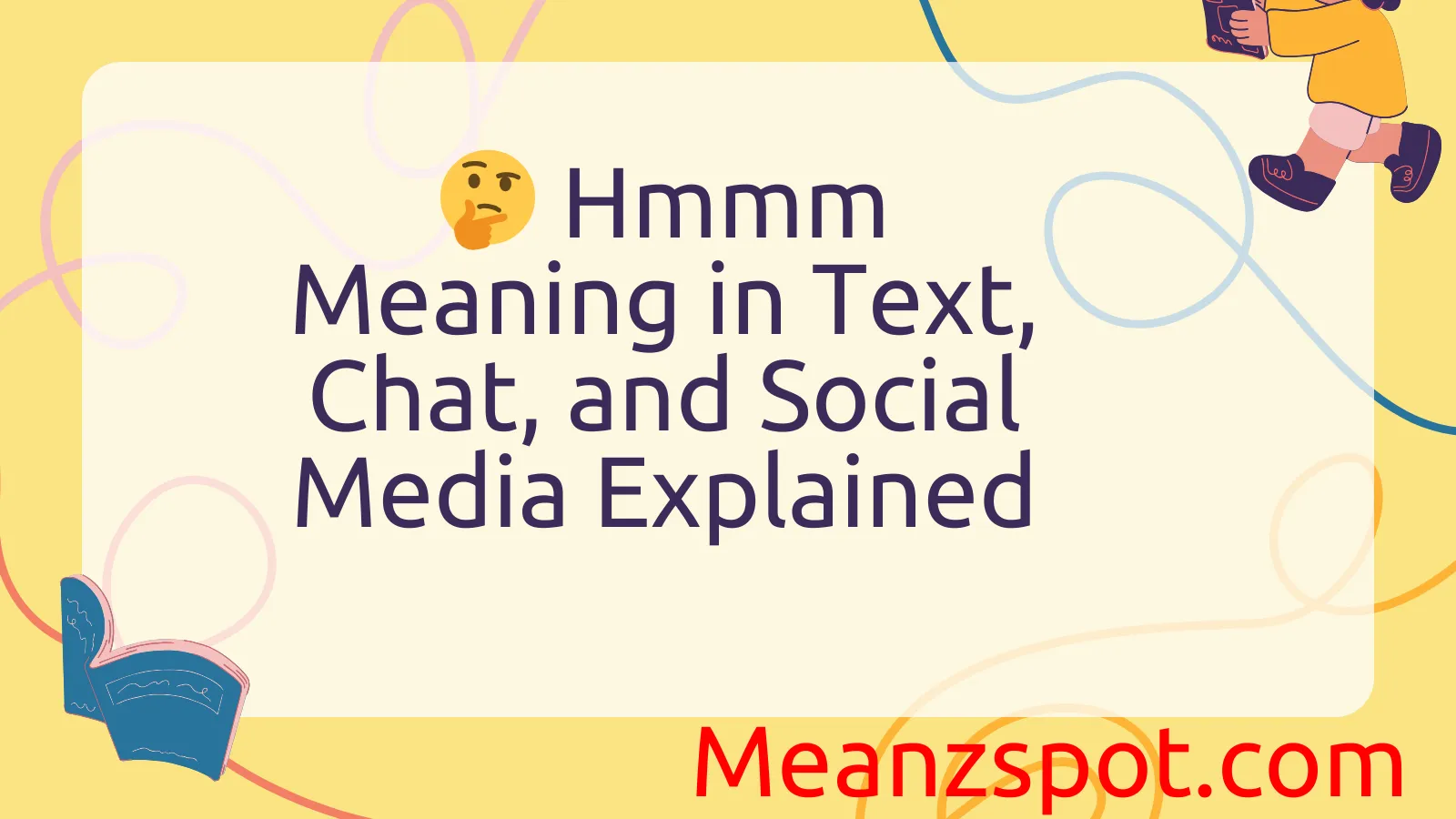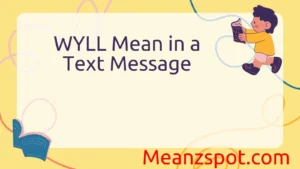Ever stared at a text that just says Hmmm and wondered what it really means? 🤔 You’re not alone! In today’s trending digital conversations, short expressions like Hmmm carry different tones depending on context. Sometimes it signals curiosity, other times it shows hesitation, and occasionally it’s used for flirting or sarcasm.
In this updated 2025 guide, we’ll break down the true meaning of Hmmm in text, chat, and social media. From playful replies to thoughtful pauses, you’ll discover how one simple word can change the vibe of an entire conversation. 💬
Definitions & Meaning
The word “hmmm” is an onomatopoeic expression—a word that mimics a sound. In text conversations, it typically represents a non-verbal sound made when someone is thinking, unsure, or hesitant. It’s often used as a filler word when a person is processing information, formulating a response, or expressing doubt or curiosity.
Here are some common interpretations of “hmmm” in text:
- Contemplation or thinking: “Hmmm… I need to think about that.”
- Skepticism or doubt: “Hmmm, are you sure about that?”
- Indifference or passive response: “Hmmm, okay.”
- Surprise or realization: “Hmmm! I didn’t expect that.”
The tone behind the word is often influenced by context, relationship between the speakers, and punctuation. For example, “Hmmm.” with a period might come across as more serious or final, while “Hmmm…” may seem more thoughtful or open-ended.
In essence, “hmmm” is a verbal pause brought into the digital world, offering a way to show that one is mentally engaged—even when silent.
Origins & History
The origins of “hmmm” trace back to spoken language long before the rise of texting and online messaging. As a sound, it mimics a natural human response when pondering or hesitating. It’s universally recognized across languages and cultures as a sign of contemplation or uncertainty.
In written form, “hmmm” began appearing in literature and dialogue transcripts to capture the natural rhythms of speech. As communication moved into digital platforms, users began adopting “hmmm” in text as a substitute for its spoken counterpart.
Historically, linguists have noted the use of such vocalizations as important elements in conversation. They serve as discourse markers—small words or sounds that help regulate dialogue. “Hmmm” serves to signal that someone is listening, thinking, or holding back an immediate reaction.
With the evolution of digital communication—from emails and instant messengers to social media—“hmmm” has been further stylized. Variants like “hmm,” “hm,” or even exaggerated versions like “hmmmmmm” have emerged, each adding a unique nuance based on length and tone.
Usage in Different Contexts
Social Media
On platforms like Twitter, Facebook, and Instagram, “hmmm” is frequently used in comments or captions to express curiosity or provoke thought. For instance, a user might post a controversial opinion followed by “hmmm…” to invite engagement or signal deeper reflection.
Text Messaging
In texting, “hmmm” often replaces verbal cues. It may indicate:
- Thinking: “Hmmm, not sure what to do tonight.”
- Sarcasm or doubt: “You said you’d call me, but you didn’t. Hmmm.”
- Mild disapproval: “Hmmm, that doesn’t sound right.”
Professional Communication
Though less common in formal emails or workplace chats, “hmmm” may appear in informal exchanges among colleagues. In these cases, it usually signals thoughtfulness or a soft disagreement, for example: “Hmmm, I see your point, but what if we tried this instead?”
Pop Culture and Memes
“Hmmm” has also become a meme-worthy phrase. You’ll often find it paired with images of people or animals appearing deep in thought, used humorously to suggest overthinking or sarcasm. In these cases, the tone is lighthearted and often ironic.
Common Misunderstandings & Clarifications
One of the most common issues with “hmmm” is its ambiguity. Without vocal tone or facial expressions, interpreting intent can be tricky. Let’s clear up a few common misunderstandings:
- It doesn’t always mean doubt. While “hmmm” can express skepticism, it often just shows someone is reflecting.
- Length matters. A short “hm” might be dismissive or indifferent, while a longer “hmmmm” suggests deeper thought or confusion.
- Context is key. In romantic conversations, “hmmm” might come across as flirtatious or mysterious. In work chats, it might seem hesitant or noncommittal.
Due to its open-ended nature, some people interpret “hmmm” negatively when no negativity is intended. When in doubt, it’s always best to clarify or ask follow-up questions.
Alternatives & Synonyms
There are several expressions that can substitute for “hmmm” depending on the intent:
- Thinking: “Let me see,” “Interesting…,” “I need to think about it.”
- Skepticism: “Really?” “Are you sure?” “That’s odd.”
- Curiosity: “What’s going on here?” “Hmm, tell me more.”
- Uncertainty: “Maybe,” “Not sure,” “Could be.”
Different languages also have equivalents, such as “mmm” in Spanish or “hmm” in Japanese, demonstrating its near-universal nature as a reflective sound.
In text, emojis are often used as alternatives:
- 🤔 (thinking face)
- 😕 (confused face)
- 🧐 (face with monocle)
Each of these offers a more visual way to communicate the same sentiment conveyed by “hmmm.”
Frequently Asked Questions (FAQ)
1. Is “hmmm” considered rude?
Not inherently, but it can be perceived as dismissive or sarcastic depending on the context. Tone and intent matter.
2. What’s the difference between “hm” and “hmmm”?
“Hm” is usually shorter and may come off as indifferent. “Hmmm” suggests deeper thought or consideration.
3. Can “hmmm” be flirtatious?
Yes, in certain contexts, especially in romantic or playful conversations, it can come off as mysterious or teasing.
4. Is it okay to use “hmmm” in professional emails?
It’s best to avoid it in formal settings. If you must convey contemplation, opt for phrases like “Let me consider that” or “Interesting perspective.”
5. How should I respond to someone who texts “hmmm”?
Consider the context. You might ask, “What are you thinking?” or clarify if they’re unsure or need more information.
6. Why do people overuse “hmmm” in texts?
It fills silence, conveys thinking, and invites conversation without giving a definitive answer. It’s a soft communication tool.
7. Are there cultural differences in how “hmmm” is interpreted?
Slightly. While the core meaning is generally understood, tone and use may vary between cultures and languages.
Conclusion
Though it may appear simple, the expression “hmmm” in text is a surprisingly rich and versatile part of digital communication. It serves as a reflection of thought, uncertainty, curiosity, or even subtle judgment—all packed into a few letters. By understanding its various meanings, contexts, and interpretations, we become better equipped to navigate conversations more thoughtfully and avoid unnecessary miscommunication.
Whether you’re a casual texter or a seasoned communicator, recognizing the power of “hmmm” can elevate the way you read and respond to messages. So next time you see “hmmm,” take a moment—because there’s usually more behind it than meets the eye.



